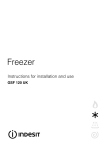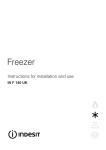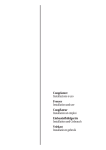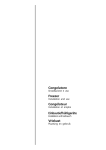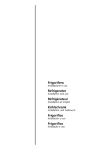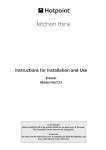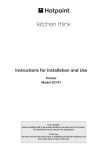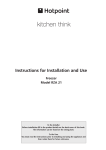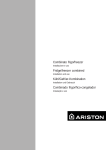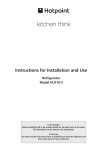Download Smeg VR105B freezer
Transcript
Safety a good habit to get into ATTENTION Read your handbook carefully since it contains instructions which will ensure safe installation, use and maintenance of your appliance. Your freezer is built to International standards (EN60) and has been awarded the European approval mark (IMQ) for compliance to UK electrical safety requirements. It also meets the EC standards on the prevention and elimination of radio interference (EC directive 87/308 - 02.06.89). with the current electrical regulations. This operation should be carried out by a qualified person. Ensure that the cable is not trapped or damaged during the installation. 5. Never pull the cable or the appliance to remove the plug from the socket. 6. Do not touch the internal cooling elements, especially if your hands are wet, since you could burn or hurt yourself. Do not eat ice cubes straight out of the freezer. 7. Before doing any cleaning, disconnect the appliance from the electricity (by pulling out the plug orturning off the general switch in your home). 8. Before disposing of your old appliance, remember to break or remove the lock as a safety measure to protect children who might lock themselves inside the appliance when playing. 9. If your appliance is not operating properly, before calling your after-sales service read the chapter on “Trouble Shooting” which might help you resolve the problem. Do not attempt to repair the fault by intervening on the internal components. 1. This appliance is designed to be used indoors and under no circumstances should it be installed outside. 2. The appliance should be used only by adults exclusively for storing foodstuffs in compliance with the instructions provided in the handbook. Under no circumstances should children be allowed to operate, or tamper with, this product. 3. For electrical safety, do not attempt to operate this appliance with wet hands or feet. 4. Do not operate this appliance connected to an extension lead. If a longer supply cable is required, this must be replaced with one of the same specifications in compliance Installation Proper installation of the appliance is essential to ensure the best and most efficient performance of your appliance. in compliance with all current electrical regulations. If the system is not earthed, the manufacturer declines all liability for consequent damages or losses. Do not use adapters of multiple sockets. Ventilation The compressor produce heat and therefore require adequate ventilation; the appliance should therefore be installed only in a room with doors or windows in order to ensure proper air circulation. Remember that the room should not be too humid. FOR ENGLISH MARKET ONLY This appliance is fitted with a continental 2-pim plug for factory testing. Before installation the plug should be cut off. The appliance is designed to be installed in a switched spur outlet fused at 13 Ampere. If the installation requires a 13 Ampere plug type to be fitted it should be conform to BS1363. Install the appliance away from heat sources Check the power load The electrical socket must support the maximum power load of the appliance shown on the data plate. The appliance should be installed at least 60 cm away from cookers, boilers, cookers with ovens, fireplaces and chimneys and at least 3 cm away from the wall. Before plugging the appliance to the mains Levelling Stand the appliance upright and wait at least 3 hours before plugging the appliance into the mains to ensure proper performance. The floor should be perfectly level; if not, you can adjust the feet at the front of the appliance. Earthing Before making the electrical connection, check that the voltage shown on the data plate, that you will find on the bottom left hand side of the appliance next to the crisper, corresponds to that of your home and that the socket is earthed GB 8 A closer look Compartment for freezing and storage Storage compartments Control Panel Defrost water drain system A B C A B D C 9 GB Control Panel Yellow Light ’’c’’ Recessed freezers have 2 different types of control panel as shown in figure 1; corresponding with the one on the appliance your have purchased. This regulates the temperature inside the appliance automatically. Turn the knob from setting 1 to 3 for increasingly colder temperatures.To adjust the thermostat, use a coin to turn the knob. Type “A” control panel. When this light is on (move the switch to the left), the compressor will operate continuously to reach the lower temperatures necessary for freezing fresh foods quickly. By moving the switch to the right (yellow light covered) the freezer is operated by the thermostat. Type “B” control panel. When lit (on setting “S”) the compressor runs continuously to reach the low temperatures necessary for freezing fresh foods. When off, the freezer is operated by the thermostat. Green Light ’’b’’ Red Light ’’d’’ Type “A” control panel. When the light is on (move the switch to the right) this indicates that the appliance is connected to the mains. When the switch is moved to the left (green light covered), the appliance is disconnected from the mains. Type “B” control panel. When lit it shows the appliance is connected to the mains. This light goes on when the temperature inside the appliance is not sufficient to preserve foodstuffs. Thermostat ’’a’’ A a c d b B a d b c Fig. 1 Setting up tour appliance ATTENTION After transport stand the appliance upright and wait at least 3 hours before plugging the appliance into the mains to ensure proper performance. Use these average temperature settings to ensure optimum performance and save energy. GB 10 Once the appliance has been connected to the mains, ensure that the green light is on and turn the yellow light on as well. When the red light is off, turn off the yellow light: the appliance is now ready for use. Using your freezer Freezing Preservation of Foodstuffs - Remember that you should never re-freeze products you have allowed to thaw, even if only partially: cook the food, then either eat (within 24 hours) or re-freeze it. - When freezing fresh foods, remember that they should not touch other previously frozen or deep frozen foods. Place the food that you wish to freeze in the top compartment where the temperature will fall below -18°C, ideal for freezing food properly. Remember that proper conservation depends on the speed of freezing. - Do not open the freezer door during freezing. - Freeze only the quantities (in kg) shown on the data plate. Important: never freeze more than the nominal amount of food .indicated on the rating plate at one time. - If a large amount of food is introduced for freezing at one time, the freezer temperature may momentarily increase inside the compartment (red light on). Since this is just a transient situation, the foods already stored in the freezer will not be harmed. - After 24 hours, freezing will be completed, turn off the yellow light. Important: .Remember to carry out this last step in order to save energy. - For the best conservation and defrosting, remember to freeze small portions; this will ensure rapid and uniform freezing. Mark the freezing date and description of the contents on the package, as shown in the table. - In the case of power failure or breakdown, do not open the freezer door. This will help maintain the temperature inside the freezer ensuring that foods are conserved for at least 9-14 hours. - Do not store full bottles in the freezer since they could explode when they freeze. (Remember that liquids increase in volume when frozen). - Fill the ice trays so that they are no more than 3/4 full. To preserve frozen and deep-frozen foods well, never set the thermostat below 1, no matter what the room temperature is. For room temperatures from 25°C to 27°C the knob should be set between 1 and 2 while for room temperatures of up to 32°C, set between 2 and 3. The maximum storage times for frozen foods are indicated in the tables “Guide for using the freezer. Always follow the instructions on the packages of deep frozen foods carefully and if there are no instructions neverkeep the food for more than 3 months from the date of purchase. When buying deep-frozen foods, ensure that they have been stored at appropriate temperatures and that the wrapping is intact. To keep the quality of the deep-frozen food unlatered, transfer it to special containers and then place it inside the storage compartment as soon as possible. If a packing shows signs of moisture and abnormal swelling, it has probably been stored at the wrong temperature and the contents have been spoiled. 11 GB Caring for your appliance Before doing any cleaning, disconnect the appliance from the electricity (by pulling out the plug orturning off the general switch in your home). Defrosting The frost should be removed from the walls of the appliance periodically. Never use sharp metal objects to remove frost because they could pierce the cooling circuit and damage the freezer beyong repair. Use the plastic scraper provided for this purpose. To defrost the appliance completely (this should be done once or twice a year), turn off the green light and leave the door open until the frost has completely thawed. A defrost water collection system is situated at the bottom of this appliance “D” as shown in figure 2. To speed up defrosting, place one or more basins of warm water inside the appliance. When defrosting, remove the frozen food from the appliance, wrap it in newspaper and store in a cool place. Since the rise in temperature will shorten the storage life of the food, it should be used as soon as possible. Fig. 2 Cleaning and maintenance The refrigerator should be cleaned periodically with a solution of bicarbonate of soda and warm water. Never use abrasives, detergents or soaps; after washing, rinse with clean water and dry with care. When these operations have been completed, turn on the green light and set the thermostat knob to the appropriate operating position. After 2 or 3 hours, the appliance will once again be ready for preserving frozen and deep-frozen foods. Trouble shooting Green Light Off Check that: The appliance is noisy. · there is no power failure · the general switch or circuit breaker in your home is not disconnected Red Light always On Check that: · the door is shut properly and that the door seals are not damaged; · the thermostat temperature knob is on the correct setting; · there is not too much frost on the inside walls. Compressor operates continuously Check that: · the yellow light is not on (continuous operating function); · the thermostat is in the correct position. GB 12 Check that: · The appliance is perfectly level; · The appliance has been installed between cabinets or other items that vibrate or are noisy. · Remember that the refrigerating gas in the cooling circuit causes a slight bubbling sound, even when the compressor is not running (this is quite normal). If after making these checks you still find your appliance doesn’t work properly, call a Service Centre, and describe the problem. Make sure that you know the model code and the relative numbers printed on the data plate located on the bottom left hand side of the appliance next to the crisper. Never call unauthorized personnel and insist on the use of original spare parts. Guide for using the freezer Meat and fish Tenderising (days) Storage (months) Tinfoil 2/3 9 / 10 Not required. Lamb Tinfoil 1/2 6 Not required. Pork Roast Tinfoil 1 6 Not required. Veal Roast Tinfoil 1 8 Not required. Veal/Pork Chops Each piece wrapped in cling wrap and then in tinfoil (4 to 6 slices) 6 Not required. Veal/Lamb Cutlets Each piece wrapped in cling wrap and then in tinfoil (4 to 6 slices) 6 Not required. Minced Meat In aluminium containers covered with cling wrap. 2 Slowly in refrigerator. Heart and Liver Plastic Baggies 3 Not required. Sausages Cling Wrap or Tinfoil 2 As necessary. Chicken and Turkey Tinfoil 1/3 9 Very slowly in refrigerator. Duck and Goose Tinfoil 1/4 6 Very slowly in refrigerator. Pheasant, Partrige and Wild Duck Tinfoil 1/3 9 Very slowly in refrigerator. Hare and Rabbit Tinfoil 3/4 6 Very slowly in refrigerator. Venison Tinfoil or Cling Wrap 5/6 9 Very slowly in refrigerator. Large Fish Tinfoil or Cling Wrap 4/6 Very slowly in refrigerator. Small Fish Plastic Baggies 2/3 Not required. Crustaceans Plastic Baggies 3/6 Not required. Shellfish Store in salted water in aluminium containers or plastic containers. 3 Very slowly in refrigerator. Boiled Fish Tinfoil or Cling Wrap 12 In hot water. Fried Fish Plastic Baggies Food Wrapping Beef Roast Freshly minced 4/6 13 Thawing Time Directly in pan. GB Fruit and vegetable Food Preparation Apples and Pears Peel and cut into slices. Apricots, Peaches, Cherries and Plums Peel and pit. Strawberries Blackberries and Raspberries Blanching Time Wrapping Storage (months) Thawing Time 2’ In Containers (cover with syrup) 12 In refrigerator very slowly. 1’ / 2’ In Containers (cover with syrup) 12 In refrigerator very slowly. Rinse and fry. In Containers (cover with sugar) 10 / 12 In refrigerator very slowly. Cooked Fruit Cut, cook and strain. In Containers (add 10% sugar) 12 In refrigerator very slowly. Fruit Juice Wash, cut and crush. In Containers (sugar to taste) 10 / 12 In refrigerator very slowly. Cauliflower Remove leaves, cut head into small pieces and blanch in water and a little lemon juice. Cabbage and Brussel Sprouts Wash and cut into small pieces. Peas 2’ Plastic Baggies 12 1’ / 2’ Plastic Baggies 10 / 12 Shell and wash. 2’ Plastic Baggies 12 Not required. French Beans Wash and slice if required. 2 Plastic Baggies 10 / 12 Not required. Carrots, Peppers and Turnips Peel, wash and slice if necessary. 3’ / 4’ Plastic Baggies 12 Not required. Mushrooms and Asparagus Wash, peel and cut up. 3’ / 4’ Plastic Baggies or Containers 6 At room temperature. Spinach Wash and mince. 2’ Plastic Baggies 12 At room temperature. Vegetable for Soups Wash and cut up in small pieces. 3’ Plastic Baggies or Containers Various Foods Preparation Blanching Time Wrapping 6/7 Storage (months) Not required. At room temperature. Not required. Thawing time Bread Plastic Baggies 4 At room temperature and in the oven. Cakes Plastic Baggies 6 About 10 minutes at room temperature, cook at 100/200°C. Cream Plastic Containers 6 At room temperature or in refrigerator. Butter In original wrapping or tinfoil 6 In refrigerator. Boiled Food or Vegetable Soup Plastic or Glass Containers Eggs Freeze without shells in small containers GB 14 3/6 At room temperature or in hot water. 10 At room temperature or in refrigerator. Kit fissaggio porte congelatore Componenti del kit Confronto particolari vecchio e nuovo Istruzioni di montaggio










